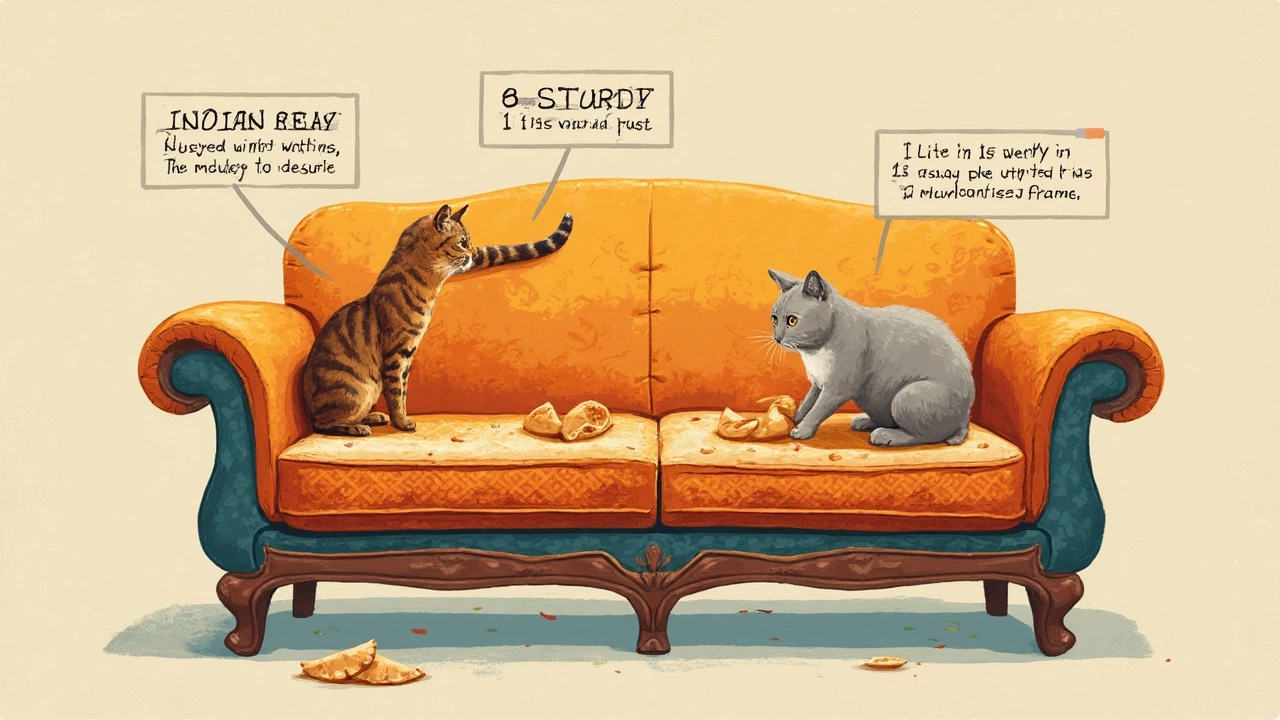Nothing bites like spending money on a sofa, only to watch it sag and stain after a couple of movie nights. With kids, pets, or just a busy life, you want a couch that takes a beating and still looks decent. So, what separates the duds from the champs?
Durability isn’t just about one thing. It’s a mix of the frame (the bones), the fabric (the skin), and even what's hiding inside the cushions. If you’ve ever had your toddler use the armrest as a jungle gym, you already know cheap couches don’t cut it. You’ll want to look at the whole build, not just the outside.
Think about who will use the sofa. Got a dog that sheds? Skip velvet. Are your kids experts at spilling juice? Leather wipes down fast, but it scratches easy. If you’re dreaming of a sofa that grows up with your family, a little research goes a long way—and can save you serious money and headaches down the road. Ready to spot the real deal from the duds? Let’s get into the nuts and bolts of what makes a sofa truly last.
- What Makes a Sofa Durable?
- Strongest Sofa Frame Materials
- Upholstery Fabrics That Last
- Cushion Fillings: What Holds Up Best?
- Smart Shopping Tips for Longevity
What Makes a Sofa Durable?
Honestly, the difference between a sofa that lasts a decade and one that falls apart in a year usually comes down to what’s under the hood—not just the pretty cover. If you care about buying the most durable sofa, you’ve got to look at how the frame, joints, fabric, and even filling are made.
Here’s the breakdown of what matters for real-life toughness:
- Frame: The best sofas have frames made from kiln-dried hardwood, like oak or maple. Particleboard, plastic, and pine just won’t last as long. Hardwood frames don’t flex, crack, or warp with normal use.
- Joints: Well-made sofas have joints that are either dowelled, glued, or screwed, not just stapled together. Ask if the corners are reinforced with blocks—it makes a huge difference for withstanding rowdy kids (or adults).
- Suspension: Eight-way hand-tied springs are hailed as the gold standard, but drop-in coil springs and sinuous springs are solid options too. Avoid sofas with only webbing or mesh; they sag quickly.
- Fabric: High-quality upholstery like tightly woven polyester, leather, or performance fabrics will take a beating better than cheap blends or loosely woven cotton. Some fabrics are even stain-proof or water-resistant now.
- Filling: High-density foam or a foam-core wrapped in down keeps its shape way longer than low-density foam or just cotton.
Here’s a snapshot of common frame and fabric types and how long you can expect them to last with daily use:
| Material | Average Lifespan |
|---|---|
| Kiln-dried hardwood frame | 10–20 years |
| Plywood or particleboard frame | 3–5 years |
| Leather upholstery | 10–15 years |
| Polyester/Performance fabric | 8–12 years |
| Loose cotton fabric | 3–5 years |
A sofa expert from Consumer Reports once said,
"The inside counts more than the outside. You can easily reupholster, but a weak frame means the whole couch will be toast before you know it."
If you want your sofa to survive anything from game nights to pet wrestling matches, pay attention to warranty, too. A solid manufacturer’s warranty (think 5-10 years or more) usually means the company stands by its product’s build.
Strongest Sofa Frame Materials
The frame is the backbone of any durable sofa. Most of us don’t think to flip a couch over and poke around, but checking the frame can save you from future sagging or creaking. Not all frames are made equal—some are built to last for years, while others just aren’t tough enough for regular use.
Solid hardwood frames are the clear winners if you want something sturdy. Woods like kiln-dried oak, maple, or ash don’t twist or warp over time. If a sofa uses these, that’s a good sign. Pine is used in some cheaper sofas, but it’s a soft wood, so don’t expect it to survive years of jumping or roughhousing.
Watch out for sofas made with particleboard, MDF, or plastic. These materials look fine when brand-new but break or wobble much faster under real-life use. You’ll find them in a lot of budget models, but that “deal” usually ends up costing more when you have to replace the whole thing sooner.
Another thing to check: joints. The best frames use dowels, wooden corner blocks, or metal screws and brackets to keep everything tight. A frame that’s just glued or stapled might hold up in a showroom but will let you down at home.
- Check under the couch: Real hardwood feels heavy and solid. If it feels light and hollow, it’s likely not the good stuff.
- Look for terms like "kiln-dried," "solid wood," or "reinforced joints" in the product details.
- If you can, wiggle the arms and back. They shouldn’t move or creak easily.
If you want your sofa to handle family life, invest in a solid wood frame—skip anything built from particleboard. It really does make all the difference in how long your couch is going to last in your living room.

Upholstery Fabrics That Last
When you’re on the hunt for a durable sofa, ignore those soft, pretty fabrics for a second and zero in on what can handle real life—pet claws, juice spills, daily wear, and more.
Some fabrics are just built tougher than others. You'll practically never see cotton or linen holding up in a busy home unless it’s mixed with something stronger. Microfiber is the go-to for families because it resists stains, feels soft, and is tough against scratches (even Daphne tried her best to wreck ours—didn’t make a dent!). Leather is another strong option, especially top-grain, which can last for decades and gets better with age. But it does scratch easier than fabric, so big pets with claws may be an issue. Then there’s polyester and synthetic blends—way better than they sound. These fabrics fight off pilling, moisture, and fading, and most ‘performance’ upholstery is actually a high-quality polyester blend.
- Microfiber (Polyester): Stain-resistant, easy to clean, doesn’t snag easily.
- Top-Grain Leather: Thick, durable, cleans with a wipe, ages well but shows scratches.
- Olefin (Polypropylene): Super tough, resists fading and staining, often used in those family-proof couches.
- Crypton/Performance Blends: Water-repellent, resists bacteria and stains—great for families or allergy concerns.
One thing most people don’t know: how tough a fabric is depends on its “double rub” rating, which is basically how many times you can rub the fabric before it wears out. The magic number? Fabrics used in homes should score at least 15,000 double rubs. Commercial sofas, like in hotels, usually shoot for over 30,000. Here’s a comparison to keep handy:
| Fabric | Pros | Cons | Average Double Rub Score |
|---|---|---|---|
| Microfiber | Stain-resistant, soft, budget-friendly | Can hold on to pet hair, less breathable | 15,000–35,000 |
| Top-Grain Leather | Extremely durable, easy to clean, timeless look | Can scratch, more expensive | 30,000+ |
| Olefin | UV & stain resistant, dries fast | Feels less soft, limited color range | 15,000–25,000 |
| Performance Polyester Blend | Repels stains, holds color, hypoallergenic | Can be pricier, not always soft | 25,000–100,000 |
So, if you’re someone who hosts movie nights with popcorn showers, has a bouncing dog, or just doesn’t want to stress every spill, stick with these hardwearing options. Skip silk, velvet, or untreated cotton—they’re fussy, and life’s too short for high maintenance furniture. Instead, make friends with the double rub tag next time you go sofa hunting—the higher, the tougher!
Cushion Fillings: What Holds Up Best?
The stuff inside your sofa cushions totally changes how comfy it feels—and how long it holds shape before it looks flat and tired. If you want the most durable sofas, pay close attention to what’s under the fabric. Not all fillings are built for the long run.
Here’s a quick breakdown of what you’ll find in most sofa cushions, plus what actually lasts:
- High-density foam: This is the heavy-duty type. It springs back, gives good support, and doesn't flatten as fast. If you want a couch that keeps its shape for years, look for foam with at least a 1.8 or higher density rating.
- Polyester fiberfill: Feels soft at first, but tends to pancake quickly. You’ll end up constantly fluffing your cushions if this is the only filling.
- Down/Feather blend: Super comfy and feels fancy, but not practical in busy homes. Down squishes down (pun intended!) and needs nonstop plumping. Plus, the feathers poke out and cause allergies for some.
- Memory foam: Molds to your shape and bounces back better than regular foam. It’s a winner for support and comfort, but can cost more.
- Innerspring core: Think mini mattress inside your sofa. Adds structure and resists sagging, especially when teamed up with foam or fiber layers.
Not sure what to pick? Here’s a table that makes it easy:
| Filling Type | Best Feature | Drawback | How Long It Lasts (Years) |
|---|---|---|---|
| High-density foam | Keeps its shape, firm support | May feel stiff at first | 5-10 |
| Polyester fiberfill | Budget-friendly, soft | Flattens quickly, loses support | 1-3 |
| Down/Feather blend | Luxury, plush comfort | High maintenance, allergies | 4-8 |
| Memory foam | Contours, pressure relief | Warms up to body heat, price | 6-10 |
| Innerspring core | No-sag support | Heavier cushions | 7-12 |
If you ask me, a combo cushion (like high-density foam wrapped in a bit of down or fiber) hits the sweet spot for both comfort and holding power. Always unzip a seat cushion in the store and look at the fill if you can. Don’t just squeeze the showroom sample—see what’s actually inside before you buy.
Quick tip: Firmer starts are better. Sofas soften over time, so going slightly firm in the beginning means your couch won’t feel saggy in a year.

Smart Shopping Tips for Longevity
So, you’re standing in the furniture store, feeling those cushiony arms and tough-looking fabrics, but how do you spot real quality? A sofa isn’t something you want to replace every few years. Here’s how to make sure your cash goes toward a durable sofa that truly lasts.
- Check the frame: If the salesperson can't tell you what the frame’s made of, that’s already a red flag. Solid hardwood like kiln-dried oak, ash, or beech can last two decades or more. Pine frames sound nice, but they actually wear out faster—sometimes sagging in just five years.
- Look at the joinery: Good sofas use screws, dowels, or wooden corner blocks. If it’s just glued and stapled, skip it. Joints matter more than you think for the sofa’s lifespan.
- Test the weight: Heavy equals sturdy. Lightweight sofas usually have cheaper materials. Try lifting the sofa by one leg—a high-quality couch won’t twist or creak.
- Ask about the warranty: A legit manufacturer will back their sofa frames and springs with a warranty of at least five to 10 years. If they don’t, they probably don’t trust their own product.
- Fabric matters: Microfiber and top-grain leather hold up best for busy homes with pets and kids. Woven fabrics last longer than prints or thin knits because the color goes all the way through the threads.
- Cushion check: High-resiliency foam wrapped in poly fiber or feather lasts way longer than budget foam alone. Flip and rotate your cushions often to keep them from getting lopsided.
Here’s a quick table with a couple stats to help you judge which materials last longest:
| Material/Feature | Average Lifespan | Best For |
|---|---|---|
| Kiln-dried Hardwood Frame | 15+ years | Heavy use, kids, pets |
| Pine/Softwood Frame | 5-7 years | Light use, short-term |
| Microfiber Upholstery | 10+ years | High-traffic homes |
| Top-Grain Leather | 10-15 years | Easy-clean, classic look |
| High-Resiliency Foam | 7-10 years | Comfort + durability |
If you’re shopping online, don’t just fall for pretty pictures. Dig into the specs, look for real customer photos, and read reviews that mention wear and tear after a year or more. If you can, sit on the couch in person: give it a wiggle, unzip a cushion if allowed, and feel the frame underneath. A little extra homework now can save you from saggy regret later.
